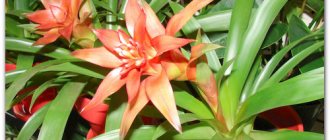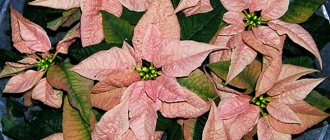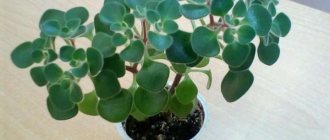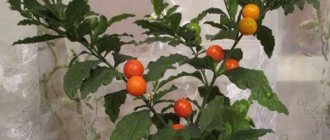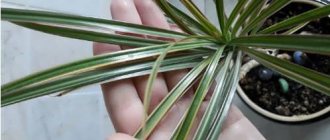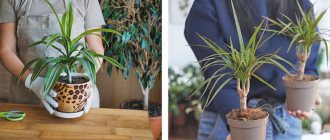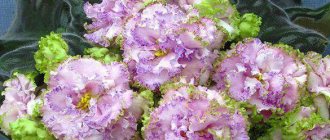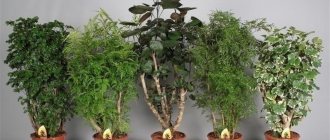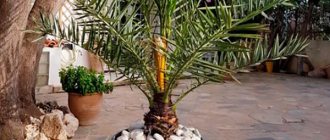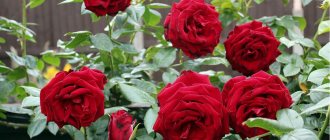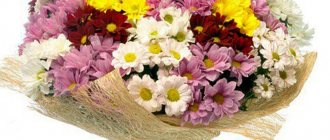Home — Botany — Houseplants — Turning the house into a tropical garden — basic recommendations for caring for Guzmania
The Guzmania indoor flower is an epiphyte from South and Central America. In nature, it grows on dying trees and receives moisture from the air. In indoor culture, this is an ordinary potted plant, quite unpretentious, but requiring compliance with several simple conditions.
The bright bracts are mistaken for flowers. Real Guzmania flowers are inconspicuous and short-lived.
The plant is evergreen tuft of long leaves with a bright, beautiful pre-flower and a short-lived flower. Guzmania is valued precisely for the leaves surrounding the flower - they can be pink, brownish and yellow, bright red and burgundy. In a room it rarely grows more than 40 cm, since it is problematic to provide “tropical” conditions in our homes.
Reed, aka Minor.
Popular types
Most often you can see a photo with reed Guzmania (aka Guzmania minor) - its distinctive features are bright bracts, shiny green leaves and the ability to bloom for a long time.
Tempo has light green leaves.
Common varieties also include:
- Mosaic Guzmania Guzmania musaica with 70-centimeter leaves forming a spreading rosette and a straight peduncle. Its leaves are decorated with brown and green stripes, and the bottom is colored red.
- Blood red Guzmania sanguinea - during the flowering period, all leaves (except for the outermost ones) turn bright red. The inflorescence of this species is not developed and is immersed in a rosette.
- Guzmania Donnell-smithii (donnell-smithii) has pale green scaly leaves and an erect flower stalk.
- Guzmania Tempo Guzmania Tempo, with light green leaves and bright bracts.
Blood red with luscious dark leaves and red spots of false flowers.
Basic requirements of Guzmania - light, temperature, humidity
Even such an unpretentious home flower as Guzmania requires compliance with certain conditions.
Many amateur aquarists breed angelfish at home; it is not difficult. How many people know what this name of popular aquarium fish means?
Look right now how beautiful and unusual the ordinary garden lilac is!
So, it is placed on western or eastern windows, in partial shade . Guzmania can only be moved to the south side in winter - this compensates for the natural lack of light.
Important! There is no need to place this delicate epiphyte on the windowsill. During the heating season it will die due to low humidity, and in summer direct sunlight will cause severe burns.
As for the temperature , even novice gardeners will not have problems here: in summer 20-25 degrees is enough, and in winter - no lower than 17. If the temperature drops to 16 degrees, the plant may get sick or not want to bloom.
The Morente look seems to imitate the colors of autumn.
to humidity , because it comes from the tropics. In summer, take it out onto the loggia, and in winter, a lighted bathroom may be a suitable place. You can place a humidifier or indoor fountain nearby. Regularly add water to the pan, but do not let it stagnate. Guzmania will also like spraying - and in the heat, “showers” can be carried out 2 times a day.
Lemon guzmania with bright yellow bracts.
About the history of appearance
The Malacca Islands are considered the birthplace of codiaum. Under natural conditions, it grows as a bush and grows up to 3 meters; at home, its growth is observed to be half that size. Young leaves grow green, but as they age they acquire multi-colored colors.
Codeium
Compared to other varieties and varieties, codiaum “Brick”, “Zanzibar” and “Petra” began to spread relatively recently throughout the homes and apartments of Russians. The unusual color of the leaf blade is increasingly finding people wanting to grow this plant.
A houseplant with green leaves with yellow spots appeared in European homes in the early 19th century. For a long time, experts studied the new plant, carried out breeding experiments, making a step-by-step description of each action, which ultimately made it possible to obtain a large number of new species and varieties.
Important! Despite the fact that codiaum (croton) looks great in any composition, it should be kept away from children. Many people ask the question: “Is codiaum highly poisonous or not?” The plant itself is not dangerous - its milk, which protrudes from the site of damage, is poisonous. While playing, children can damage the plant, which will lead to the baby getting dirty with its juice, which causes burns on the skin.
Rules for watering and fertilizing
Caring for Guzmania at home means maintaining an optimal microclimate and proper watering. The main recommendations here are:
- a small amount of water is poured directly into the outlet, and the remaining water is removed after a few minutes;
- water the soil rarely - only if it is very dry;
- In winter, 1-2 waterings per week are sufficient, and in summer, daily watering is required;
- overwatering is more dangerous for Guzmania than overdrying;
- For spraying, use only clean water, and to remove dust, the leaves are occasionally wiped with a cotton swab.
The magnificent Donella-Smith.
When Guzmania blooms, it needs mineral supplements . It is worth buying a special complex for bromeliads that dissolves in water. Fertilizers in the form of a solution are also applied to the outlet. The frequency of feeding is once a month.
Interesting! If Guzmania is in favorable conditions, but does not bloom, then place apple slices in a bag on the ground (just make sure that they do not become moldy over time). The fruit will release ethylene and the plant will bloom very quickly.
Replanting Guzmania - when needed
The roots of the plant develop extremely slowly, and therefore it does not need regular replanting. But it’s still worth replanting Guzmania if:
- You purchased a flower in a transport pot . You need to prepare a wide pot, up to 15 cm deep, and place drainage at the bottom. A suitable soil mixture is a combination of coarse sand, sphagnum, peat and turf soil. Handle the roots carefully when transplanting. Lightly cover the relocated plant with soil and then water it.
- You separate the “baby” from the old bush . The replanting process is the same, but you will have to carefully separate the plant's root systems. The mother plant is not viable after flowering and is discarded.
Mosaic look. The transverse stripes on the leaves resemble a pike tail.
How to grow Mesembryanthemum plant at home
These dwarf succulents can form dense colonies with almost continuous cover on coastal bluffs, along the seashore and on the edges of saline wetlands. Plants tolerate salty soils well. Let us describe in more detail how to care for indoor Mesembryanthemum.
Soil requirements
The flower grows well in regular, well-drained garden soil. It is suitable for a wide range of soils - from light (sandy) and medium (loamy) to heavy (clayey) soils. The main condition is a well-drained soil mixture. The succulent can even grow in saline soils as long as it is in a well-lit area. Like any other succulent, Mesembryanthemum will benefit from a regular potting mix purchased from a garden center, to which you can add perlite. You can also form the soil mixture yourself. For this, regular garden soil (50%), perlite or coarse sand (20%) and compost (30%) are suitable.
Potty requirements
Mesembryanthemum grows very quickly and well, already in the first year after planting.
Photo of Mesembryanthemum in a pot (flickr.com)
This must be taken into account when choosing a container for a flower. It should be wide and deep enough, with a drainage hole. The succulent's root system is quite developed.
Lighting indoor Mesembryanthemums
The main requirement of the plant is good lighting. This succulent does not tolerate shade. In partial shade there will be little, if any, flowering; in full shade you will have difficulty keeping the plant alive. Keep this in mind when choosing a place for a flower pot.
Frost resistance
These are heat-loving crops and do not tolerate frost. If you are growing indoor Mesembryanthemum, try not to overcool the flower in winter.
Watering
During the growing season, houseplants should be watered regularly.
But you need to wait for the soil to dry before the next watering. In winter, the frequency of moisturizing should be reduced to a minimum.
Fertilizer
If you grow succulents in pots, fertilize every 15 days in the summer with mineral fertilizers for cacti and succulents, diluted twice as much. There is no need to feed in winter.
Transplanting domestic Mesembryanthemums
It is best to repot plants when they are actively growing, when they have enough energy to reestablish their roots.
How to replant your flowers?
- You can reuse the same pot and simply renew the soil if the plant has not outgrown its pot. Otherwise, purchase a pot one size larger;
- When you remove the plant from its pot, be careful to disturb the roots as little as possible;
- Carefully remove the old soil;
- Place the plant's roots in the new pot and add soil around the flower until it is held securely;
- Water the soil thoroughly.
Information on caring for succulents
Succulents of the genus Apthenia
What, how and when to fertilize succulents - expert advice
Succulents of the genus Delosperma
How to prolong the pleasure - propagating Guzmania
Growing this tropical beauty is easy. But there comes a time when the flower dies and the plant loses its decorative effect. You can preserve the “tropical paradise” if you know how Guzmania reproduces .
Even during the flowering period, the plant forms a “baby” - usually one. The young flower grows very quickly and by the time the “parent” dies, it will already reach 15 centimeters in height. It is easy to know that a plant is ready to divide: the bract begins to dry out and the leaves turn pale.
Important! Before dividing, check that the children have roots. If they grow poorly, remove the peduncle in advance - this will stimulate their development.
After the mother plant withers, the children can be separated - this is done with a sharp knife. Baby Guzmania should be immediately planted in the prepared substrate, and the pot should be small, because the plant is small. Remember to use drainage to prevent your young plant from dying from overwatering. Reproduction of Guzmania is not difficult, so very soon you will be delighted with new bright flowers.
Anthurium - how to grow, how to care for, how to propagate. This indoor flower is called male happiness, and it is believed that it brings love and harmony between spouses to the house.
It turns out that aloe can be grown not only for health, but also for beauty. More details can be found here.
What to do with the huge aerial roots of indoor monstera? The answer to this question can be found at the link www.razmnojenie.ru/botanika/komnatnye-rasteniya/monstera.html.
Problems in caring for Mesembryanthemum
Once rooted, the succulent suffers from several pests and diseases. Most problems occur in young plants.
Root rot attacks plant roots when they are in soil that contains too much moisture. The disease is caused by a fungus that easily spreads throughout the garden. If your young flowers look wilted, stunted or yellowing, and they are in the ground or in a container that does not drain properly, you may have root rot. The roots of a healthy flower should be firm and white. Having taken the plant out of the ground, you noticed that its roots are brown and soft - the plant is affected by root rot.
Slugs, snails and aphids love to eat young parts of plants, but otherwise Mesembryanthemum is resistant to pests and diseases. Prevention is the best medicine. Make sure your soil drains well. Add perlite or organic matter to improve water drainage. Also make sure the plants have good air circulation.
Possible difficulties and diseases
Guzmania is easy to grow because it tolerates even unfavorable conditions. However, this plant also has its risks:
- The main pests that can affect Guzmania are: spider mites, scale insects. If parasites are found, wipe the leaves with soapy water, and if the infestation is severe, use insecticides.
- Regular waterlogging can lead to rotting of the root system.
- The plant may become infected with a fungus , as indicated by gray spots on the leaves. To get rid of it, you will need a fungicide.
The fungus began its destructive work from below.
